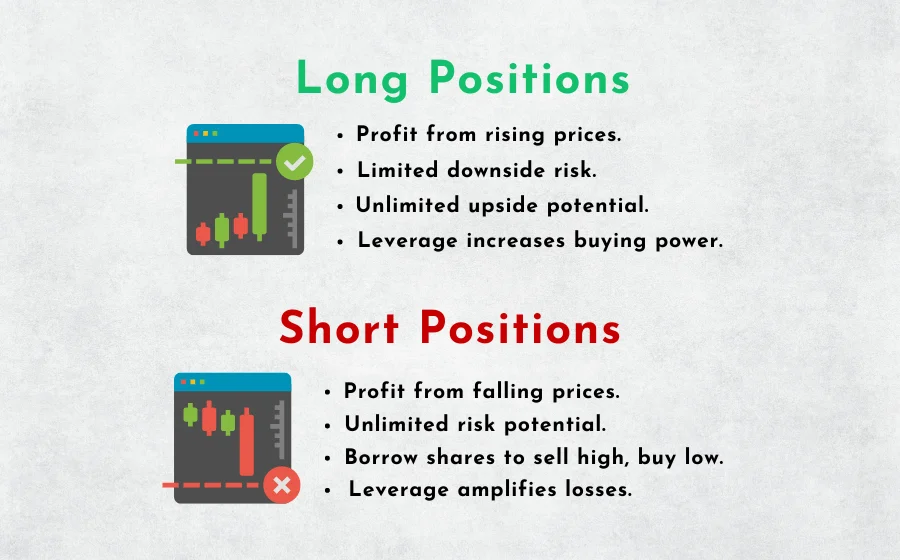
KEYTAKEAWAYS
- Margin trading lets investors borrow funds to increase buying power, amplifying both gains and losses. While it offers higher return potential, it also carries greater risks and requires careful management.
- Understanding long vs. short positions is key, as they carry different risks and profit potentials. Effective risk management strategies like stop-loss orders and diversification are essential.
- Crypto margin trading offers higher leverage and returns but comes with greater volatility and risks. It demands constant market awareness and strong risk management.

CONTENT
What is margin trading? It allows investors to borrow funds to increase their trading position and amplify returns. Learn the basics, pros and cons, and key tips for both beginners and experienced traders.
WHAT IS MARGIN TRADING?
Margin trading is a practice that allows investors to borrow money from a broker to purchase securities, effectively leveraging their investment capital. This method enables traders to take larger positions in the market than they could with their available funds alone. The borrowed funds, known as the margin, act as a loan from the broker, with the securities purchased serving as collateral.
To engage in margin trading, investors must first open a margin account with their broker. This account type differs from a standard cash account in that it allows for borrowing. The amount an investor can borrow depends on the margin requirement set by the broker, which is typically a percentage of the total trade value.
- Example of Margin Trading:
Let’s break down how margin trading works with a simple example:
- Initial Capital: You have $10,000 to invest.
- Broker’s Margin Requirement: The broker sets a 50% margin requirement.
- Total Purchasing Power:
– With margin: $20,000 ($10,000 your money + $10,000 borrowed)
– Without margin: Only $10,000
- Buying Shares:
– Stock price: $100 per share
– With margin: You can buy 200 shares ($20,000 ÷ $100)
– Without margin: You could only buy 100 shares ($10,000 ÷ $100)
- Potential Scenarios:
– If the stock price rises to $120:
※ With margin: Profit = (200 × $120) – $20,000 = $4,000
※ Without margin: Profit = (100 × $120) – $10,000 = $2,000
– If the stock price falls to $80:
※ With margin: Loss = $20,000 – (200 × $80) = $4,000
※ Without margin: Loss = $10,000 – (100 × $80) = $2,000
Note: This example doesn’t account for interest on the borrowed amount or other potential fees.
It’s important to note that margin trading can be applied to both long and short positions. In a long position, an investor borrows money to buy securities, anticipating that their value will increase. Conversely, in a short position, an investor borrows securities to sell, hoping to buy them back at a lower price in the future.
>>> More to read : Crypto Trading Strategies for Beginners
WHAT ARE MARGIN TRADING PROS & CONS?
Like any investment strategy, margin trading comes with its own set of advantages and disadvantages. Understanding these pros and cons is crucial for any investor considering this approach.
-
Advantages
1. Increased Buying Power: The primary advantage of margin trading is the ability to control a larger position with a smaller amount of capital. This increased buying power can potentially lead to greater profits if the investment performs well.
2. Diversification Opportunities: With access to more capital, investors can diversify their portfolios more extensively, potentially reducing overall risk.
3. Flexibility: Margin accounts often offer more flexibility than cash accounts, allowing for various trading strategies and quick execution of trades.
4. Potential for Higher Returns: If an investor’s predictions are correct, the use of leverage can amplify returns significantly.
-
Disadvantages
1. Magnified Losses: Just as margin trading can amplify gains, it can also magnify losses. If an investment moves against the trader, losses can exceed the initial investment.
2. Interest Charges: Brokers charge interest on the borrowed funds, which can eat into profits or increase losses over time.
3. Margin Calls: If the value of the securities in a margin account falls below a certain threshold, the broker may issue a margin call, requiring the investor to deposit additional funds or securities.
4. Increased Risk: The use of leverage inherently increases the risk of the investment, potentially leading to substantial financial losses.
5. Emotional Stress: The volatility associated with leveraged positions can lead to increased emotional stress for investors, potentially affecting decision-making.
WHAT IS MARGIN TRADING | LONG POSITIONS VS. SHORT POSITIONS
One of the key aspects of margin trading is the ability to take both long and short positions. Understanding the differences between these strategies is crucial for any investor looking to engage in margin trading.
Long Positions
A long position in margin trading involves borrowing money to purchase securities with the expectation that their value will increase. This is the more traditional and intuitive form of investing. Here’s how it works:
- An investor identifies a stock they believe will increase in value.
- They use their own capital plus borrowed funds from the broker to purchase more shares than they could afford on their own.
- If the stock price rises, the investor can sell the shares, repay the loan, and keep the profit.
For example, let’s say an investor has $5,000 and borrows an additional $5,000 on margin to buy $10,000 worth of Stock A, currently priced at $100 per share. They can purchase 100 shares instead of just 50. If the stock price rises to $120, the position is now worth $12,000. After repaying the $5,000 loan, the investor’s profit is $2,000, representing a 40% return on their initial $5,000 investment (minus interest and fees).
Short Positions
Short positions in margin trading are more complex and involve borrowing securities to sell them, with the expectation that their value will decrease. Here’s the process:
- An investor identifies a stock they believe will decrease in value.
- They borrow shares of this stock from their broker and immediately sell them at the current market price.
- If the stock price falls, the investor can buy back the shares at the lower price, return them to the broker, and keep the difference as profit.
For instance, if an investor shorts 100 shares of Stock B priced at $50, they receive $5,000 from the sale. If the stock price falls to $40, they can buy back the shares for $4,000, return them to the broker, and keep the $1,000 profit (minus interest and fees).
It’s important to note that short positions carry theoretically unlimited risk, as there’s no upper limit to how high a stock’s price can rise. This makes short selling particularly risky, especially in margin trading where losses can exceed the initial investment.

(Source: CoinRank)
Comparing Long and Short Positions
Both long and short positions in margin trading offer opportunities for profit, but they come with different risk profiles:
- Long positions have limited downside risk (the stock can’t go below zero) but unlimited upside potential.
- Short positions have limited upside potential (the stock can’t go below zero) but theoretically unlimited downside risk.
The choice between long and short positions often depends on the investor’s market outlook, risk tolerance, and overall investment strategy.
>>> More to read : 10 Best Technical Indicators for Crypto Trading in 2024
WHAT IS MARGIN TRADING | KEY TIPS FOR MANAGING RISK
While margin trading can offer significant opportunities, it also comes with substantial risks. Here are some key considerations and risk management strategies for investors:
- Understand Your Risk Tolerance: Before engaging in margin trading, honestly assess your risk tolerance. The potential for amplified losses means this strategy isn’t suitable for everyone.
- Start Small: If you’re new to margin trading, start with a small portion of your portfolio to gain experience and understand the dynamics involved.
- Use Stop-Loss Orders: Implement stop-loss orders to automatically close positions if they move against you beyond a certain point. This can help limit potential losses.
- Monitor Your Positions Closely: Margin positions require active management. Keep a close eye on market movements and be prepared to act quickly if necessary.
- Maintain a Margin Cushion: Keep additional funds or securities in your account beyond the minimum requirements. This can help you avoid margin calls if the market moves against your positions.
- Understand the Costs: Be aware of all costs associated with margin trading, including interest charges and any fees. Factor these into your potential returns.
- Diversify Your Positions: Don’t put all your margin-trading capital into a single position. Diversification can help mitigate risk.
- Have an Exit Strategy: Before entering a trade, have a clear plan for when and how you’ll exit, both for profit-taking and loss mitigation.
- Continuous Learning: The financial markets are constantly evolving. Stay informed about market trends, economic indicators, and changes in margin trading regulations.
- Use Leverage Wisely: Just because you can use maximum leverage doesn’t mean you should. Consider using only a portion of your available margin to reduce risk.
- Understand Margin Requirements: Different securities may have different margin requirements. Be aware of these differences and how they might affect your trading strategy.
- Practice with a Demo Account: Many brokers offer demo accounts where you can practice margin trading with virtual money. This can be an excellent way to gain experience without risking real capital.
>>> More to read : How to Read Crypto Charts: A Beginner’s Guide to Market Analysis
WHAT IS MARGIN TRADING IN CRYPTO?
Margin trading in the crypto market follows the same basic principles as in traditional financial markets, but with some unique characteristics and increased risks.
- Higher Leverage: Crypto exchanges often offer significantly higher leverage ratios compared to traditional markets. While stock markets typically offer 2:1 or 3:1 leverage, some crypto exchanges offer up to 100:1 or even higher.
- Increased Volatility: Cryptocurrencies are known for their high volatility. This can lead to rapid and substantial gains, but also to severe losses in a short period.
- 24/7 Market: Unlike traditional stock markets, crypto markets operate 24/7. This requires constant vigilance from traders engaged in margin trading.
- Funding Rates: In crypto perpetual futures, which are popular for margin trading, traders pay or receive funding rates periodically. These rates can significantly impact profitability.
- Liquidation Risks: Due to high volatility and leverage, the risk of liquidation is higher in crypto margin trading. Exchanges may liquidate positions quickly to prevent losses from exceeding the trader’s account balance.
- Regulatory Uncertainty: The regulatory landscape for cryptocurrencies is still evolving in many jurisdictions, which can add an extra layer of risk to margin trading.
- Platform Risks: Crypto exchanges may be more vulnerable to hacks or technical issues compared to traditional brokerages. Traders need to consider the security and reliability of the platform they use.
- Diverse Asset Options: Crypto margin trading isn’t limited to major cryptocurrencies like Bitcoin and Ethereum. Many platforms offer margin trading on a wide range of altcoins, providing diverse opportunities but also increasing complexity.
>>> Check more : How to Read Crypto Charts: A Beginner’s Guide to Market Analysis
Crypto margin trading offers high potential returns but comes with significant risks due to high leverage and market volatility, which can lead to quick losses. Investors must understand the market, apply effective risk management strategies, and avoid risking more than they can afford to lose.
Margin trading can expand market exposure and increase potential profits, but improper management can result in large losses. Understanding the mechanics, including long and short positions, and implementing strong risk management practices are essential for navigating this strategy successfully.
Not all investors are suited for margin trading, as it requires deep market knowledge, a high risk tolerance, and quick decision-making under pressure. Before starting, thorough research, self-assessment, and seeking professional advice are highly recommended.
>>> Learn more :
What Is MACD? How It Works in Crypto Trading
What Is Crypto Staking?: Overview, How It Works, & Future
What is Day Trading? Comprehensive Guide to Crypto Day Trading for Beginners


















